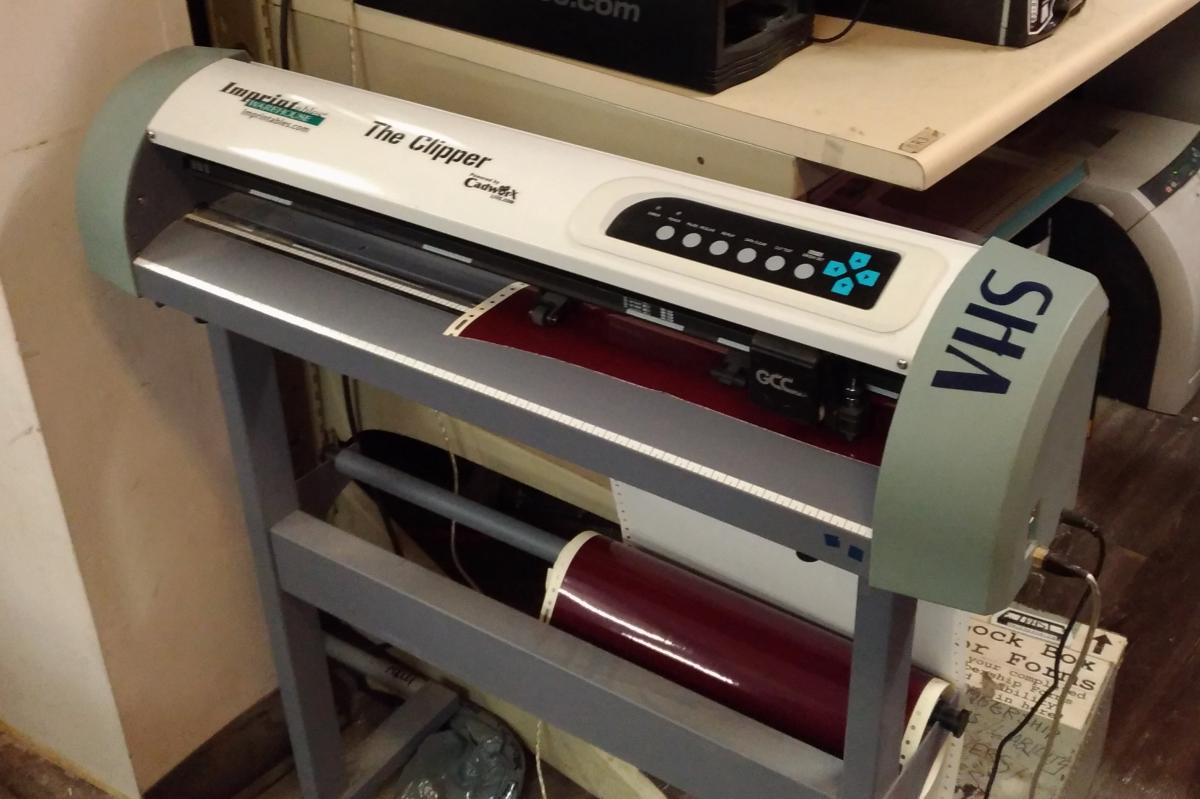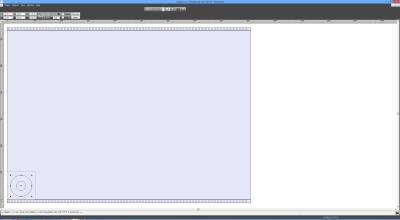Table of Contents
Clipper Vinyl Cutter
We have a Clipper vinyl cutter, which looks like a rebadged GCC AR-24, although both Stahls and Imprintables sell 2.5mm blades specifically for The Clipper. See below for additional sourcing options.
This page is a work in process. Feel free to improve it!
Relevant Talk posts
Using It
The vinyl cutter is connected to the black computer beside it (the one that has solidworks installed - has “HACKTHEPLANET!!!” on the side).
You can use either VectorCut or GreatCut 3 to import artwork and send it to the cutter.
Importing graphics (GreatCut)
With GreatCut 3, you can import either bitmap graphics (JPEG, PNG, BMP) or vector graphics (DXF, PSD, EPS, etc). Since the cutter itself runs on vectors, they are definitely the preferred format, but sometimes you only have a bitmap to go with.
Vectors
Vectors, the preferred format for the cutter, are usually created by software such as Adobe Illustrator, Adobe Photoshop, or The GIMP (which is free software, and pretty good).
I (@lefty) have had the best luck importing PSD (Photoshop) vectors as .psd files. These seem to translate well into the software without a lot of extra tweaking. .EPS and .AI files will work, but GreatCut tends to choke on the objects sometimes - missing lines and strange cuts, etc. Solid shapes tend to work best, as the cutter can just cut the outside of the shape, but it will entirely depend on the final result you'd like.
To import a vector, create a new job with File → New, then File → Import. Pick the vector file you'd like to import, and check that it shows up in the Preview window. GreatCut is a bit finicky on the formats it will successfully import, but if it shows up in the preview, it should import successfully.
After it's imported, you can move, resize, and otherwise manipulate your object. It should be ready to cut after that.
Bitmaps
Importing bitmaps (PNG, BMP, JPG, etc) to GreatCut is relatively straightforward, but requires a couple of extra steps.
To import a bitmap, create a new job with File → New, then import with File → Import. Pick the bitmap file you'd like to import, checking that it appears correctly in the Preview window.
Once the bitmap is imported, you may need to convert it to a cutting vector. Select your imported graphic, then click Tools → Contour Line.
You may need to play with the settings a little bit, but for the initial run try the defaults. If your bitmap is fairly cut-friendly, it'll add lines for the cutter path but leave the original graphic. Delete the original graphic if you're happy with the cutter lines that were generated, otherwise delete the cutter lines and try the Contour Line tool again.
Cutting
- Load the vinyl into the cutter machine.
- First release the two pinch rollers at the back of the machine by pulling the levers up.
- Move the material freely through the machine and also move the rollers from side-to-side depending on the position and size of the vinyl stock.
- Once it is positioned and aligned, push the levers down to engage the pinch rollers and lock everything in place. This also sets the boundaries of your cutting area, so be sure to set the locking rollers beyond your cut job but still moving the vinyl. Try not to push the vinyl too close to the edges, as it will tend to bind up and cause skewed cuts.
- Send your cut job
- In VectorCut, click “Send Cut Job” and wait a few seconds. Be careful to not click this button multiple times, or you will queue multiple cut jobs to the cutter.
- In GreatCut, click the cutter icon, and do “Test Drive” which will cause the cutter to outline the artwork on the material without depressing the blade. Do that until you're happy with the position.
Blades
Chances are the blade is dull and you won't get a very good cut. To replace the blade, open the bracket on the traveling cut head and remove the cylindrical part. Unscrew the top to get at the blade. Don't lose any of these parts!
We now have two different blade holders, a darker one that holds 2.5mm diameter blades, and a silver one that holds 2mm diameter blades.
Since the 2mm blades are much more common and easier to come by, there is almost no reason to use the 2,5 mm holder.
Blade Angle
According to the knowledge base linked below:
Blade angle: 45 vs. 60 degree : Most vinyl materials have two layers, a Release liner or “backing” and the vinyl itself. The cutter is designed to cut completely through the vinyl without cutting completely through the backing. When loading the material, the vinyl should be facing up. Establishing which side is up should be fairly straight forward with most materials. When cutting heat-transfer vinyl, the backing will be the shiny (glossy) side of the material. Place the clear plastic glossy side down when loading it into the cutter.
The primary reason for blades with different angles, is cutting depth. A lower angle (45 degree) is great for thin materials, while a steeper angle (60 degrees) has a more vertical cutting orientation that penetrates deeper. An increased amount of blade dragging through the material when cutting fine detail can cause, what they call, vinyl ears (parts lifted up). With minimal blade in the material, a 60 degree blade tends to cause fewer, if any, vinyl ears.
Using a 60 degree blade on everyday cutting is a waste of a blade, technically speaking. Less of the blade's cutting area is used, and blade life is wasted. The more horizontal cutting orientation of the 45 degree blade accurately distributes the cutting task over a larger blade area, and thus last longer (and is cheaper).
So use a 45 degree blade always, unless a 60 degree blade is needed for thick or more custom types of cutting, if 45 degrees blades are not available.
A visual step-by-step
Once you've imported your file according to the steps above,the first thing you'll want to do is to set up your Working Area to understand how your artwork fits on your material.
1.Working Area To do this go to Settings > Working Area on the top menu panel.Once in the pop-out window you can adjust the width and height of the Working area to the required size.
2.Resizing Generally you might need to resize and reposition your artwork. You can do this in the parameters window, see image below.
3.Artwork positioning The actual position of your artwork relative to the working area doesn't have any bearing on the final output as the software relocates your artwork to the zero point before outputting. You can check the final position of your artwork in the Preview tool. This is a representation of what will be cut. File>Output>Preview
4.Output Once you're happy with how the preview looks you're almost ready to get cutting. First you need to check some of the parameters. File>Output.
-Pressure - I recommend 250-275 (thicker material may need more). Nich's Update: I tested with 250 and cut right through, and found that for the material I found in the scraps bin, 75 was about right, though there was a small bit of bunching on tight corners.
-Speed - 5cm/s (slow down further if you have intricate cuts)
-Material - Width & Length, this is important as if you don't set it large enough, the program will cute up some of your design thinking you need to add a new material roll.
-Weed Box - this will cut an offset box around your artwork, depends on whether you want to save material or not.
5.Cutting Turn the machine on (it will run some automatic calibrations). Slide the material from the back of the machine under the rollers and past the blade point. Lock down the two rollers at the back to keep the material in place. Using the arrows, manoeuvre the cutter head to the starting point of your choice on the material. Push the Sizing Origin Set button on the machine to set that as the origin (zero) point. Click Output on GreatCut and the program will run.





